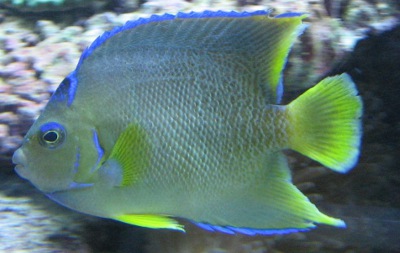Bermuda Angelfish
Category: Angelfish

Facts about Bermuda Angelfish, "Scientific name for Bermuda Angelfish is Holacanthus bermudensis". Bermuda Angelfish is a variety of sea angelfish that comes from the Pomacanthidae family. The Bermuda Angelfish varieties are native to Bermuda, and they are largely found in the western part of the Atlantic, ranging from the Bahamas, Bermuda and Florida to the Mexican Gulf, and to the Yucatan in Mexico, too. The Bermuda Angelfish breeds are inclined to stay close to corals, rocks, and sponges at varying depths, ranging from 10 feet to 302 feet (3 meters to 92 meters). The Bermuda Angelfish also survive around the stones, in caves, and gaps in shallow water. Juveniles of this fish variety used to survive in channels and bays.
Features
The Bermuda Angelfish breed is a violent fish that attains a maximum body length of 18 inches (45.7 cm) when matured. The Bermuda Angelfish appear with a blue-brown colored body, with bright yellow and green hues on the tip of their fins and tail. However, juveniles of the Bermuda Angelfish breed have totally a different body color. They appear with a dark blue colored body, with a yellow-colored tail and some yellow shades on their fins. This fish variety also has perpendicular blue-colored bars on its body. As the Bermuda Angelfish grows, the bars will vanish and their body color turns out to be lighter and some greens and browns are added.
The Bermuda Angelfish breed has a big mouth and their teeth look like a comb. The Bermuda Angelfish is regularly gathered for aquariums. Occasionally, these fish varieties cross with the similar queen angelfish. This hybrid variety of fish is called as the Townsend Angelfish. The matured Bermuda Angelfish will make a loud whipping sound that startles divers and warns predators, too.
Diet
The fact is that a Bermuda Angelfish are omnivorous, (definition-they eat both other animals and plants). Usually, Bermuda Angelfish breeds, feed mainly on sponges, but they also feed on jellyfish, tunicates, and corals, including algae and plankton in the wild. In the aquarium, they are fed with meaty foods and algae-based foods. When you first get your Bermuda Angelfish, it may need to be given live foods such as freshly chopped seafoods or brine shrimp or to encourage them to eat.
Breeding
Bermuda Angelfish breeds have no exact reproduction period, so they breed throughout the year. When breeding, the female Bermuda Angelfish can discharge eggs, ranging from 25, 000 to 75, 000 eggs every day, with a total of 10 million eggs during every breeding cycle. The eggs are see-through and include a drop of oil intended for buoyancy.
The maximum lifespan of the Bermuda Angelfish breed is 20 years
Ideal aquarium water temperature for your Bermuda Angelfish is between 72 to 78º F (22to 25.5º Cel) and pH from 8.1 to 8.4. The specific gravity at 1.020 to 1.025.
Bermuda Angelfish Aquarium care
Test the water when preparing your tank for your Bermuda Angelfish Aquarium: You will need to purchase a liquid tester so that you can test for Nitrates and Ammonia. The strip-style test kits are unreliable and a waste of money. You should use a dechlorinating product to remove the harmful chlorine from the water. Test for nitrite, ammonia, and proper PH. The ammonia should always be 0, the nitrite should be 0, and the nitrate should preferably be below 20 ppm. If it's at or above 40 parts per million (ppm), you have too many fish or are not changing the water often enough. Cycling your tank is important, Follow the steps to cycle your tank. This establishes healthy bacterial and chemical levels.
When buying your Bermuda Angelfish see which one looks like the healthier fish in the tank. Be wary of tanks with dead fish in them, as this can be a sign of illness or improper care. Clamped fins are a sign of illness. In addition, healthy Bermuda Angelfish will have no white spots, make sure they swim with their fins held upright, and have a nice rich color or colors. Make sure they swim all over the tank and look healthy.
When adding the Bermuda Angelfish to the aquarium, it is important to introduce the Bermuda Angelfish to the tank environment slowly. As soon as you get home, float the entire, closed pet store bag (with the Bermuda Angelfish inside!) in the tank on top of the water for about a half hour. This will allow the water in the plastic bag and the Bermuda Angelfish to equalize out to the same temperature as in your tank, so your fish does not get shocked by the different temperature. Next, add a small amount of water from your tank to the bag, and wait about 15 minutes. Do this at least one more time. Us a net to catch your Bermuda Angelfish and then while the Bermuda Angelfish is in the net, dispose of all the water down a drain or outside. Then transfer the Bermuda Angelfish carefully into the your tank. This process not only reduces stress for you Bermuda Angelfish, it also prevents the dirty pet store water from contaminating your tank with disease.
Remove 30% of the water from you Bermuda Angelfish tank each month with new water, or a 15% water change every 2 weeks is ideal for keeping nitrates lower. With corals in the Bermuda Angelfish tank, then 20% water change every month, or 10% change every 2 weeks.
Fish are omnivore, (definition-they eat both other animals and plants).

 Back To Category Angelfish
Back To Category Angelfish